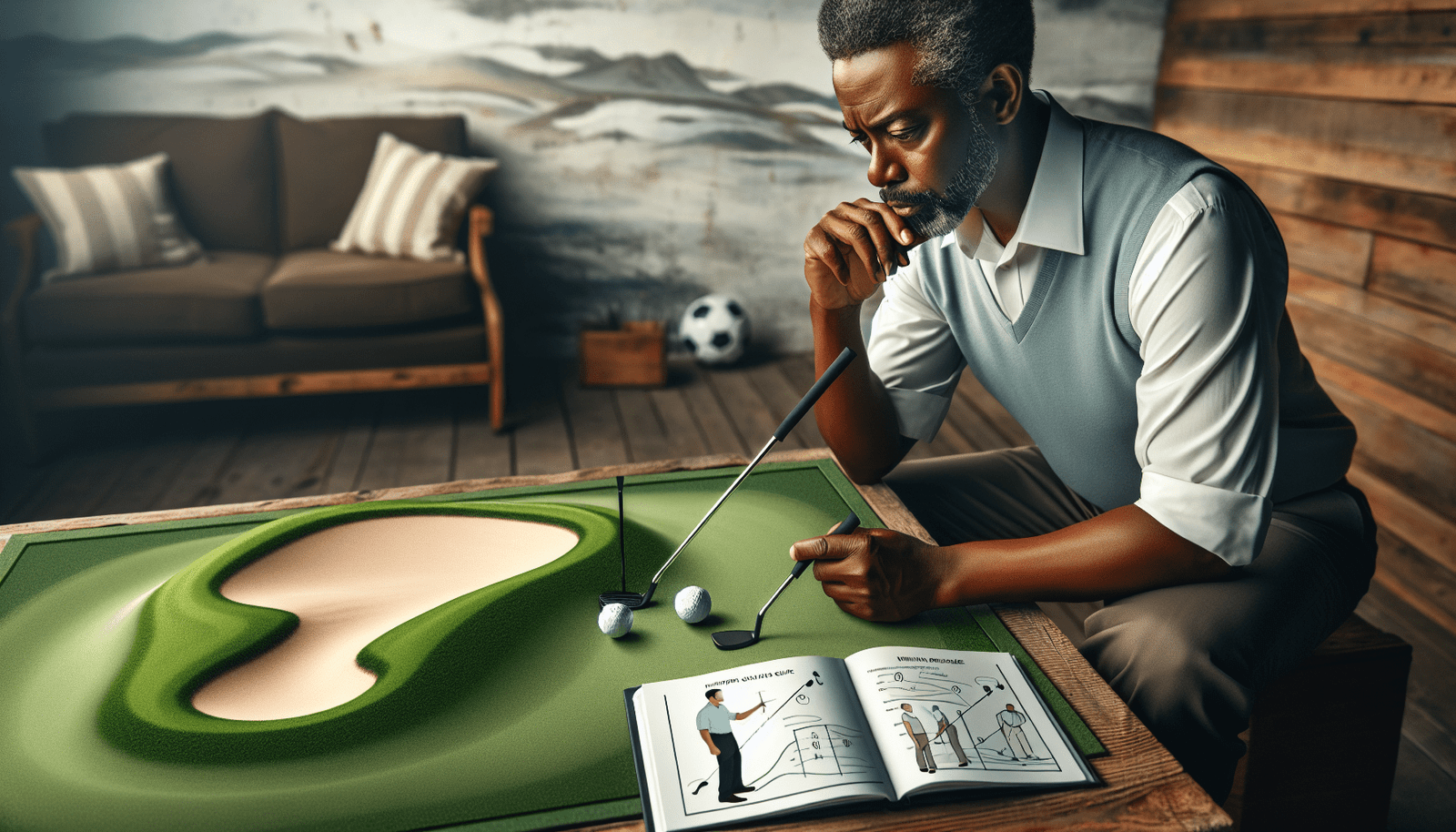
So, you’ve found yourself on the golf course, standing by the green, feeling determined to conquer that seemingly elusive putt. But as you gaze upon the hilly, undulating terrain, you can’t help but wonder, how do you actually read a green and ultimately improve your putting? Fear not, because in this article, we will unveil the secrets to deciphering the subtle mysteries of the green, allowing you to confidently sink those putts and lower your score. Prepare to unlock the keys to mastering the art of reading a green and transforming your putting game.
Understanding Green Reading
Green reading is a crucial skill that can significantly impact your putting performance on the golf course. By understanding the nuances of the green, you can make more accurate reads and sink more putts. This article will guide you through the importance of green reading, factors to consider when reading a green, analyzing the slope and contour of the green, and various techniques to improve your green reading skills.
The Importance of Green Reading in Putting
Green reading plays a vital role in successful putting. It involves assessing the characteristics of the green, such as slope, contour, and grain, to determine the ideal path for your putt. Proper green reading helps you anticipate the break and adjust your stroke accordingly, leading to better accuracy and more made putts. By neglecting green reading, even the most skillful putter may struggle to navigate the challenging terrain of the golf course.
Factors to Consider When Reading a Green
Several factors come into play when reading a green. The most obvious one is slope – the degree of incline or decline on the putting surface. Uphill putts will be slower than downhill putts, and you need to adjust your speed and stroke accordingly. Another important factor is contour, which refers to the shape and undulations of the green. These contours can affect the break of your putt, causing the ball to curve left or right. Finally, consider the influence of grain – the direction in which the grass blades grow. Grain can significantly impact the roll of the ball, and understanding its effect can help you make more accurate reads.
Analyzing the Slope and Contour of the Green
To analyze the slope and contour of the green effectively, it’s crucial to observe it from different angles. Walk around the green and view it from various positions to get a complete understanding of its topography. Pay attention to any noticeable slopes or undulations that may affect the path of your putt. Additionally, using your feet to feel the slope can provide valuable tactile feedback. By walking along the line of your putt and sensing the changes in elevation, you can better visualize the break and adjust your aim accordingly.
Observing the Green from Different Angles
When it comes to green reading, changing your perspective can make a significant difference. By approaching the green from different angles, you can gain a better understanding of its contours and slopes. Move around the green, viewing it from the front, back, and sides. This allows you to perceive the subtle breaks and undulations that may not be apparent from a single viewpoint. Take your time to observe the green from multiple angles before making your putting decision.
Using Your Feet to Feel the Slope
Your feet can serve as valuable sensors when it comes to green reading. By walking along the line of your putt and feeling the slope with your feet, you can develop a more intuitive understanding of the contours. As you traverse the green, notice any changes in elevation or slope. Is the ground rising or falling? How steep is the slope? By collecting these sensations, you can mentally map out the break and adjust your aim accordingly. Trust your feet to guide you toward better green reading and more accurate putts.

Utilizing a Green-Reading Book or Smartphone App
In the digital age, technology has made its way into the world of green reading. Many golfers rely on green-reading books or smartphone apps to assist them in analyzing the slopes and contours of the greens. These resources provide detailed diagrams and measurements, allowing you to visualize the break accurately. However, keep in mind that using such tools may not be legal in all golf competitions, so check the rules before relying on them. Regardless, utilizing a green-reading book or smartphone app during practice can be a helpful training aid to sharpen your green reading skills.
Identifying Uphill and Downhill Putts
One of the key aspects of reading a green is determining whether you have an uphill or downhill putt. Uphill putts require more force to reach the hole due to the effect of gravity. Conversely, downhill putts tend to roll faster and require a softer touch to avoid overshooting the target. By correctly identifying these putt types, you can adjust your approach and ensure the appropriate speed and line for your putt.
Determining the Influence of Grain on the Green
Grain refers to the direction in which the grass blades grow on the green. This factor can significantly influence the roll of your putt. When putting against the grain, the grass will create more friction, slowing down the ball. Conversely, putting with the grain will result in a faster roll as the blades offer less resistance. It’s crucial to determine the influence of grain on the green and adjust your line and speed accordingly. By carefully observing the texture and appearance of the grass, you can make more accurate green reading decisions.
Reading the Break Through Reference Points
To read the break effectively, it’s helpful to identify reference points on the green. Look for objects, such as divots, ball marks, or color changes, that can serve as indicators of the break. Analyze the line between your ball and the hole, focusing on these reference points to gauge the direction and severity of the break. By understanding the relationship between these markers and the path of your putt, you can visualize the break more clearly and make more accurate green reading decisions.
Understanding the Impact of Green Speed
Green speed is a critical factor that affects your putting performance. Faster greens require a lighter touch and a more delicate stroke to prevent the ball from racing past the hole. On the other hand, slower greens necessitate a firmer stroke to ensure the ball reaches the target. Understanding the impact of green speed on your putts is essential to gauge the appropriate force and manage your distance control effectively.
Evaluating the Effect of Grain on Putting
Grain, which we discussed earlier, also plays a role in the speed of the green. Putting into the grain will slow down the ball, while putting with the grain will make it roll faster. Evaluating the effect of grain on the green is crucial for accurate distance control. Take into account the grain direction when planning your putt, as it can influence the ball’s speed and travel. By incorporating grain into your green reading process, you can make more precise adjustments and improve your putting performance.

Adjusting Your Putting Stroke for Different Green Speeds and Grain
To adapt to varying green speeds and grain conditions, you must adjust your putting stroke. On faster greens, focus on a softer and smoother stroke to control the speed and prevent the ball from excessive roll. When dealing with slower greens, use a firmer stroke to generate enough momentum and ensure the ball reaches the hole. Similarly, consider the grain direction when striking your putt. If putting into the grain, add a touch more power to compensate for the grass’s resistance. Conversely, for a putt with the grain, a gentler stroke should suffice. By understanding the interplay between green speed, grain, and stroke adjustments, you can fine-tune your putting technique for optimal performance.
Setting Up a Putting Drill Using Tees and Cups
A great way to practice green reading is by setting up a putting drill using tees and cups. Place tees in a circle around the hole at various distances and positions. Create a realistic simulation by placing the tees to replicate common break patterns. Start from different locations and practice reading the break as you putt toward the cups. This drill helps you develop your green reading skills while improving your accuracy and distance control.
Practicing Distance Control and Reading Breaks
Distance control and reading breaks go hand in hand when it comes to successful putting. A useful drill to enhance both skills is to place cups at different distances on the putting green. Start from a short distance and gradually work your way up to longer putts. As you practice, focus on reading and adjusting for the break while maintaining consistent distance control. By incorporating both elements into your practice routine, you can develop a well-rounded putting game.

Simulating Various Green Conditions for Realistic Practice
To prepare yourself for different green conditions, it’s important to simulate a variety of scenarios during practice. Seek out greens with different speeds, slopes, and undulations to replicate the challenges you may encounter on the course. Practice sessions on flat, slow greens should be balanced with sessions on fast, undulating greens. By experiencing a range of conditions, you can improve your adaptability and build confidence in your green reading abilities.
Developing a Consistent Pre-Shot Routine
A consistent pre-shot routine is essential to improve your putting accuracy. Establishing a ritual that you perform before each putt helps you focus, eliminate distractions, and set yourself up for success. Your pre-shot routine may include visualizing the putt, finding a comfortable stance and grip, aligning yourself with the target, or taking a practice swing. By executing the same routine before every putt, you create a sense of familiarity and build muscle memory, leading to improved consistency and accuracy on the greens.
Enhancing Your Alignment and Setup
Proper alignment and setup are critical for accurate putting. Ensure that your feet, hips, and shoulders are parallel to the target line. Align yourself correctly to the intended path of the putt. Consider using alignment aids, such as alignment sticks or a putter with alignment lines, to help you position yourself accurately. Additionally, check your posture, grip, and ball position to ensure optimal setup for a successful putt. By honing your alignment and setup, you create a solid foundation for accurate green reading and improved putting performance.
Practicing with a Putting Mirror for Feedback
A putting mirror can be a valuable training tool for enhancing your putting technique. Placing a putting mirror on the ground allows you to assess your alignment, eye position, and stroke path. As you practice your putting stroke, use the mirror to check if your eyes are directly over the ball and if your stroke follows a straight back and through motion. The mirror provides instant feedback, helping you identify any flaws or inconsistencies in your putting mechanics. By incorporating a putting mirror into your practice routine, you can make adjustments and develop a smoother, more accurate stroke.
Mastering the Art of Lag Putting
Lag putting refers to the ability to control the distance of your putt, especially on longer putts. It’s important to develop a feel for the green and understand the relationship between green speed and distance. When facing a lengthy putt, focus on the weight of your stroke rather than worrying about making it into the hole. Practice lag putting by hitting putts to different distances, gradually increasing the length. By mastering the art of lag putting, you can leave yourself with shorter, more manageable second putts and reduce the risk of three-putting.
Using a Metronome to Establish a Consistent Tempo
A metronome can be a helpful tool to establish a consistent tempo in your putting stroke. Set the metronome to a beat that feels comfortable and matches your natural rhythm. As you practice, synchronize your stroke with the metronome beat, maintaining a consistent tempo throughout. This repetition helps develop muscle memory and promotes a smoother, more rhythmical putting motion. By incorporating a metronome into your practice routine, you can cultivate a consistent tempo that brings stability to your putting game.
Mental Exercises to Enhance Visualization
Visualization is a powerful tool for improving your green reading skills. Mental exercises, such as closing your eyes and visualizing the path of the putt, can enhance your ability to read breaks. Before every putt, take a few moments to visualize the ideal line and the ball dropping into the hole. Try to see the contours of the green and imagine how the ball will react to the slope. This mental rehearsal improves your focus and helps you make more accurate green reading decisions.
Using Visual Markers to Aid Alignment
Visual markers can assist you in aligning yourself to the target line. For example, using intermediate targets like a spot or a blade of grass a few feet in front of your ball can help you aim more accurately. These markers act as guides and reference points during your setup and stroke. By utilizing visual markers, you can align yourself more consistently and confidently, improving your overall putting accuracy.
Practicing with Closed Eyes for Increased Feel
Closing your eyes during practice putts can enhance your feel for the green. By removing the visual distraction, you rely solely on your sense of touch and intuition. Stand over the ball with your eyes closed, take a few practice strokes, and putt towards the hole. This exercise enhances your awareness of the green’s contours and the impact of your stroke on the ball’s roll. While it may feel unfamiliar at first, practicing with closed eyes can ultimately improve your feel and green reading abilities.
Relaxation Techniques to Reduce Anxiety
Putting can be nerve-wracking, especially in high-pressure situations. Incorporating relaxation techniques into your routine can help reduce anxiety and improve your putting performance. Deep breathing exercises, visualization of a calming scene, or positive self-talk are effective ways to relax your mind and body. By staying calm and composed on the green, you can maintain a steady stroke and make more confident reads.
Building a Positive Mindset and Self-Belief
Having a positive mindset and self-belief is crucial for success on the greens. Visualize yourself sinking putts and trust your abilities. Instead of dwelling on past mistakes or missed putts, focus on the present shot and the process. Building a positive mindset creates a confident, resilient attitude that will serve you well on the putting green. Remember, every putt is an opportunity to succeed, so approach each one with self-assurance and belief in your skills.
Focusing on Process Rather Than Outcome
Putting your focus on the process rather than the outcome can help you become a better green reader. Rather than obsessing about making or missing a putt, concentrate on executing your green reading techniques and making a solid stroke. By focusing on the process, you reduce unnecessary pressure and allow your instincts to guide you. Trust your preparation and commit to your reads and strokes, knowing that the outcome will take care of itself.
Exploring Laser and Digital Green-Reading Devices
For golfers seeking advanced green reading assistance, laser and digital green-reading devices can be valuable tools. These devices use technology to provide precise measurements and visual representations of slope and contour. Laser devices measure the elevation changes on the green, allowing you to gauge the severity of slope. Digital devices, such as tablets or smartphones, offer interactive maps that display the green’s topography. While these tools can enhance your green reading, it’s important to remember that they may not be permitted in all golf competitions. Familiarize yourself with the rules and restrictions before utilizing such devices.
Using Slope Maps and Heat Maps for Decision-Making
Slope maps and heat maps are useful visual aids to assist you in making informed decisions on the greens. Slope maps depict the elevation changes on the green, providing valuable insights into the break and slope severity. Heat maps are color-coded diagrams showcasing areas of the green where putts are more likely to break. By analyzing these maps, you can assess the likely path and magnitude of the break, aiding your green reading process. While slope maps and heat maps can be incredibly helpful, always be aware of any restrictions on their use during sanctioned golf events.
Seeking Professional Guidance Through Golf Technologies
If you’re serious about improving your green reading skills, seeking professional guidance through golf technologies is an option worth exploring. Golf technologies, such as launch monitors or putting analysis systems, can provide in-depth data and insights into your putting mechanics. Professional coaches and trainers can utilize this information to offer tailored guidance and support. By leveraging the expertise of these professionals and utilizing cutting-edge golf technologies, you can accelerate your progress and elevate your green reading abilities.
In conclusion, green reading is an essential skill that can significantly impact your putting performance. By understanding the factors that affect green reading, such as slope, contour, and grain, and employing various techniques and drills, you can improve your green reading abilities and sink more putts. Remember to practice consistently, maintain a positive mindset, and embrace technological advancements to assist you on your journey to becoming a master at reading greens.